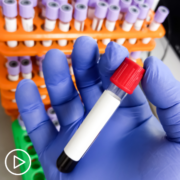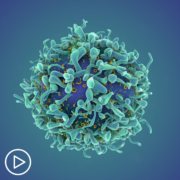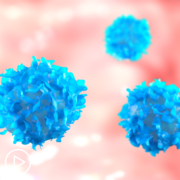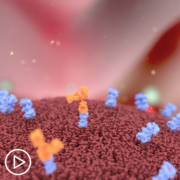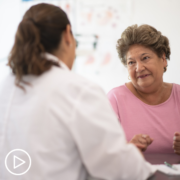How can you elevate your overall myeloma care and treatment? Myeloma expert Dr. Sikander Ailawadhi discusses advances in myeloma care, the importance of patient participation in myeloma treatment decisions, and shares key advice and resources for self-advocacy.
Related Resources:
Transcript:
Katherine:
Hello and welcome. I’m your host, Katherine Banwell. It’s no secret that the quality of care that patients receive can vary depending on a number of factors and patients who are educated about their condition and involved in their care may have improved outcomes. That’s why the Patient Empowerment Network developed the Elevate Series, which aims to help patients and care partners be informed about their disease and more confident participating in conversations with their healthcare team.
In today’s program, we’re going to hear from an expert to learn more about myeloma and hear tips and advice for accessing better overall care. Before we get into the discussion, please remember that this program is not a substitute for seeking medical advice. Please refer to your healthcare team about what might be best for you. Well, let’s meet our guest today. Joining us is Dr. Sikandar Ailawadhi. Dr. Ailawadhi, welcome. Would you please introduce yourself?
Dr. Ailawadhi:
Yes. Thanks a lot, Katherine. Thanks for this opportunity. To all our viewers, listeners, I’m Sikandar Ailawadhi. I’m one of the hematologists oncologists at Mayo Clinic in Jacksonville, Florida. So, at this Jacksonville, Florida site of Mayo, I lead our myeloma group, and we have a very comprehensive program with inpatient outpatient treatment and lots of clinical trials, cell therapy, et cetera. I look forward to the discussion.
Katherine:
Well, thank you so much for joining us today. I know you’re a busy man. I’d like to start by discussing your role as a researcher. You’re on the front lines of advancements in the myeloma field. So, what led you here, and why is it so important to you?
Dr. Ailawadhi:
Yeah. So, Katherine, thanks for asking that question because before jumping into the disease state and clinical trials and data, et cetera, I think it’s important for all of us to keep in mind what kind of brought us here or what kind of keeps driving us further. So, I think for me, the decision to come to the field of multiple myeloma was very strongly influenced by my mentors.
My mentor who shaped my career and also got me interested in this area. I think during my training, it was the time that newer drugs were just beginning to come about. So, the field of myeloma was just beginning to change. And since then, obviously, there have been lots of advancements, lots of research, clinical trials, new drugs, so that the outlook for not only the myeloma patients has improved quite a bit.
But also, for physicians, researchers, us academicians who work in this field, the opportunities are much, much more. And because I trained at a large academic center, I – and again, with working with my mentor, I got so interested in the clinical research because frankly giving the available drugs is one thing but being at that cutting edge where you can bring newer drugs to life, newer drugs to our patients’ lives, that was what was most important for me and is the driving force for my work today.
Katherine:
Thank you for that explanation, Dr. Ailawadhi. I appreciate it. So, when it comes to choosing therapy for myeloma, it’s important to work with your healthcare team to identify what might be best for you. How would you define shared decision-making and why is this so critical to properly managing life with myeloma?
Dr. Ailawadhi:
Excellent question, Katherine. Shared decision-making or a process in which the physician, the health care team, and the patient, their caregivers, everybody comes together, shared, to make a decision that we feel is in the best interest for that patient at that time. That is the whole concept.
Whenever we think about treatment decisions, in our mind, the three main components that have to be considered every single time. Not just newly diagnosed or relapsed or third line or whatever, every single time a treatment decision has been taken, we must consider patient-related factors. What is their preference? What are their goals? Do they have caregiver support? How far do they live? Do they want IV? Pills? Any side effects that are there?
Comorbidities? Other issues? Financial conditions? Everything comes into play, patient-related factors. Then, there are disease-related factors. How fast is the disease growing? Is this new? Is this old disease, high-risk, low-risk, or standard risk? Or what has been given before, et cetera. So, patient and disease-related. And the number three is the treatment-related factors. What is being considered for the patient? What are the ins and outs, pros, and cons?
All of this has to be laid out in front of the patient and preferably also their caregiver if the patient has someone who they can share their decision with.
And when we put all of that in the mix, we come up with a decision which is hopefully in the patient’s best interest. They are more likely to go through with it. They are informed. They are involved in their care. And then, hopefully, if the patient starts on a treatment that they are interested in, knowledgeable about, and committed to, we’ll be able to keep the patient on that longer term and get the best benefit out of it.
So, in my mind, the main reason for shared decision-making is to make sure my patient is committed to that treatment. They understand that treatment. And we make this kind of bond between us as clinicians and our teams and the patient and their home team, their family team, their caregiver team so that everybody is working together with a singular goal. Right treatment for the right patient at the right time because it must be patient-centric, not research or clinician, or drug-centric.
Katherine:
Yeah. Okay. That’s good advice. What are myeloma treatment goals, and how are they determined?
Dr. Ailawadhi:
So, I think the myeloma treatment goals can be very different depending on what vantage points you’re looking from. My treatment goal is to provide the best treatment for my patient that has least side effects, gets a deep control, and my patient’s able to live long with a good quality of life. Okay. But that’s my goal. I need to figure out what my patient’s goals are, and sometimes our patient’s goals are very different. A patient’s goal might be that they want to really avoid side effects. Well, they want to live, lead their quality of life, and keep traveling. And this happens on a day-to-day basis.
Just the other day, one of the patients said, “Well, I really want to keep driving around in my RV with my wife, because that is what we had wanted to do at this point of our life. What can you do to help me control my disease, but keep me driving my RV?” And we literally had to figure out where all they were traveling. We identified clinics close to them and connected with physicians so that they could continue their treatment wherever they were. So, the patient’s goals are very important, and in fact, I would say they are paramount. So, understanding what the patient wants. They may be wanting to control pain. They may be wanting to just live longer.
They may be wanting to delay treatment so that they could watch their daughter’s soccer game. I’m just saying that the goals can be very different. It is important to lay them out. Every time you’re making a treatment decision, the goals should be laid out into short-, mid-, and long-term goals. I should bring my goals to the discussion. The patient should bring their goals to the discussion, and we come up with whatever is the best answer for them that suits them.
Katherine:
So, you’re trying to maintain an open dialogue, an open line of communication, yeah.
Dr. Ailawadhi:
Absolutely.
Katherine:
What sort of tests should be done following a myeloma diagnosis?
Dr. Ailawadhi:
Generally, when myeloma is suspected, we need to know what the basic blood counts are, something that is called a CBC, complete blood count. We’re looking for anemia, low white blood cells, low clotting cells, or platelets. We want to do serum chemistries or blood chemistries, looking for kidney function, liver function, electrolytes, calcium, et cetera.
Then, we want to do some kind of an imaging of the body. Generally, routine X-rays are no longer done, and the most preferred is a PET-CT scan, a PET scan. We do PET-MRIs frequently. So, there are different tests available, but you want a good test to know what’s the state of bones and presence of any lesions or tumors. And then, the important question comes is doing a bone marrow biopsy.
The reason for doing a bone marrow biopsy, and even if somebody has had a biopsy done from a compression fracture, et cetera, that diagnosed myeloma, a bone marrow biopsy still should be done. It gives us a lot of pieces of information.
It tells us what is the percentage of plasma cells in the bone marrow. So, what is the disease burden we are starting with? Secondly, that bone marrow biopsy specimen can be sent for what is called a FISH testing, which is fluorescent in situ hybridization.
It is basically looking for any mutations in the cancer cells. Based on those mutations, myeloma can be classified into standard or high-risk myeloma. And sometimes our treatment choices are differed based on whether somebody is standard or high-risk. So, blood work, basic counts – and I skipped over one of the things. Right after chemistries, I wanted to add also are myeloma markers.
There are typically three lab tests of myeloma markers. One is called protein electrophoresis. It can be run in blood and urine. Ideally, it should be run in both. One is immunoglobulin levels, which gives us the level of IgG, IgA, IgM, et cetera. And the third one is serum-free light chains, which is kappa and lambda light chains. Neither one – none of these tests eliminates the needs for the other.
So, everybody, in the beginning, should have complete blood count, blood chemistries, SPEP or serum protein electrophoresis, urine electrophoresis, immunoglobulins, light chains, imaging, and then a bone marrow. This completes the workup. Then, based on that, the treatment can be determined.
Katherine:
Well, you mentioned lab work. How often should tests and blood work be done?
Dr. Ailawadhi:
Good question. Very, very important question because we see very frequently that the patients come in, they’re getting treatment somewhere, and every single time the patient steps foot in the door of that institution or wherever they’re going, they got a blood draw. That’s how they start their day. It’s needed more frequently in the beginning but needed less frequently later on.
Generally, the myeloma markers, those protein electrophoresis, immunoglobulins, light chains, they are frequently done just about every month. Generally, in myeloma, one month, three to four weeks is one cycle. So, at the beginning of every cycle, you want to know how good your response was. So, the myeloma markers once a month.
The blood counts and chemistries in the first month, first one to two months, they can be done every other week or so just to make sure counts are fine, no need for transfusions, kidney/liver is okay, et cetera. But after the first couple of months, when the body is used to the drugs when the patient is settled with the treatment, frankly, once-a-month labs are good enough. We don’t really need labs on every single treatment visit. Because the other thing that happens is some of these drugs can lower the blood counts normally during treatment, but they have a rest period at the end of the cycle when the counts recover.
So, if somebody does labs in the middle of the cycle when the counts are expected to be down but not an issue, treatments are stopped, and growth factors are given. And this is done, but that is not really necessary. So, first couple of one to two cycles, maybe every other week to make sure counts are okay. Myeloma markers monthly, but after the first couple of months when things are settled, once a month should be sufficient.
Katherine:
Okay. What questions should patients be asking about their test results?
Dr. Ailawadhi:
Yeah. Very, very, very important. In fact, whenever I’m speaking in a patient caregiver symposium or anything, I spend a lot of time on these test results because frankly, a lot of times it sounds like jargon and the people talk about, “Oh, my ratio is going up,” or the doctor is saying, “Hey, your immunoglobulins are normal. You’re in remission.” But so, I think the patients need to understand and ask from their doctors, “What is my marker of the disease that you will be following?” And I’ll tell you that immunoglobulins, that IgG or IgA level, is nearly never the marker. It’s either M spike or light chains, generally one of those.
So, the patients need to understand what is their marker. They also need to know what did their bone marrow show. What was the percentage and what was the FISH result or cytogenetic result? I think other than the tests, I will also add the patients need to ask their doctor a lot of these questions that you’re asking me. How frequently are the labs going to be done? Why is it important? Why was a certain treatment selected? What is the expected outcome? What are the chances that I can go into remission? How long does the intense treatment stay?
When does it go to some kind of a maintenance? Et cetera, et cetera. Basically, you want to understand everything about the disease and its treatment. It is overwhelming. This is a lot of information. A lot of times the patients may say, “Well, I got a diagnosis. I got a treatment started. I just need to move on.” That’s right. But once you spend all that time initially understanding your diagnosis and the treatment and the disease, it’ll make the rest of the journey much, much easier.
Katherine:
That’s really helpful as we drill down a little further. What are the types of treatments available for people with myeloma?
Dr. Ailawadhi:
So, myeloma has a lot of treatments available. We can classify these treatments into different classes of drugs, or we can classify the treatment as early lines or late lines of therapy. Or we can classify these treatments into cellular therapy or targeted therapy or chemotherapy. There are ways of classifying it. What I would suggest is we should think about classes of drugs. We have something called proteasome inhibitors. That class has three drugs FDA-approved. We have something called immunomodulatory drugs. That class has three drugs also approved, but generally, we use two.
Then, there are something called monoclonal antibodies. There are three drugs approved there as well.
There are cellular therapies or CAR T-cell therapy. There are two of them approved. There is also a stem cell transplant that is used as a part of treatment sometimes but is different from CAR T. Then, there are other immunotherapy, something called T-cell engagers, in which also there are three drugs approved. In fact, as I’m saying to you, I’m trying to think…yeah, wow. Every class has three drugs. That’s so weird. And then, there are some other classes of drugs. There is something called exporting inhibitors. There is a drug there. All said and done, there are these different classes of drugs.
There are some guiding principles for myeloma treatment. Generally, three to four drug combinations or regimens are better than two drugs. So, a patient should be in the initial therapy or later lines. Also, preferably be getting a three-drug combo. And I forgot to mention steroids, which are an important part of every regimen in myeloma, almost every regimen. So, three drugs or four drugs are better than two. That’s important to keep in mind. Longer durations of treatment are generally considered better. We should not tinker with the regimen’s recipe too soon. As long as the patient is tolerating for a longer duration before making any major changes like maintenance.
Generally, maintenance in myeloma is not a response-assessed thing like, “Oh, you’ve responded in two months. We should go to maintenance.” Generally, in myeloma, maintenance transition is a time-dependent thing. Okay, you’ve had six or nine months or 12 months. We can go to maintenance, sort of a thing. So, even if somebody has responded, they may need the same treatment for a longer period of time to keep the disease quiet.
And so, I think these are the different categories of drugs. We pick and choose from different categories to combine and make a regimen. The CAR T-cell therapy, the two CAR Ts that are approved, or the three T-cell engagers that are approved, they are all currently used as single agents. They are not combined with anything, not even with steroids.
Katherine:
Yeah, I see. How do clinical trials fit into a treatment plan?
Dr. Ailawadhi:
Okay, that’s an extremely important question, and you’re asking it from a person in my clinic about two-thirds of the patients who are on treatment at any given time are on clinical trials. So, I am very heavily, I shouldn’t say biased, but a proponent of clinical trials. In my opinion, clinical trials are a part and parcel of treatment for every single patient. In fact, when you look at the NCCN guidelines, which are National Comprehensive Cancer Network, which is large institutions across the country, and they make guidelines for all cancers, it is mentioned in every single setting that clinical trials should always be considered.
So, I personally feel that whenever the patient is coming up with a treatment decision, we talked about shared decision-making in the beginning, it’s important for them to ask at every single juncture, “Do you have any clinical trials available for me?
And if you don’t have any clinical trials available, are there any clinical trials that I should consider, even if it means going to a different place and getting an opinion?” I know logistically it’s challenging, but we should at least know our options. So, in my opinion, clinical trials should be considered at every single juncture, because that is how patients get access to either a new drug, a new treatment, or a different way of using the current drugs, which might actually improve upon their current state. So, everybody all the time should consider clinical trials.
Katherine:
That’s great information, Dr. Ailawadhi. Thank you for that. I’d like to add that if you’re interested in learning more about emerging treatments, such as CAR T-cell therapy, PEN has a number of resources available for you, and you can find these at powerfulpatients.org/myeloma, or by scanning the QR code on your screen.
So, the symptoms of myeloma, as well as the side effects of certain medications, can vary greatly among those being treated. How do you approach symptom management with your patients?
Dr. Ailawadhi:
It is extremely important that we focus on the symptoms, whether it’s coming from the disease or it’s coming from the treatment. Because frankly, if a person is responding to the treatment, you want them to stay on the treatment for a longer duration of time, so the disease can stay controlled.
If we don’t handle the symptoms from the treatment or the side effects that are happening or if the disease is causing too many symptoms, it is more likely that either we’ll start cutting down the drug too much or stopping the treatment, et cetera, and then the disease just comes back. In some cases, that is necessary, but generally we would like to modulate the treatment or address the symptoms.
So, one important piece that we should do, or at least we try to do over here, is that every single time that we talk to the patient for any of the visits – while there is enough time spent on, “Well, these are your labs, your diseases responding markers, SPEP, and M spike, and light chain,” and all that stuff – we spend a lot of time asking about symptoms.
It is, I understand, challenging to cover everything, but to familiarize what drugs cause what kind of symptoms, and at least making sure that we ask those from the patient. For example, IMiDs like lenalidomide (Revlimid) can cause some diarrhea, can cause fatigue, can cause sleepiness. Well, I must ask about diarrhea from all my lenalidomide patients.
Bortezomib (Velcade) can cause neuropathy. It can give rise to shingles. I must ask my patients for every bortezomib-treated patient. “Hey, do you have any neuropathy numbness, or tingling?
Are you taking your medication to prevent shingles, et cetera?” I’m just saying we may not be able to do a comprehensive review of every single symptom from every single patient, but whatever the target side effects are important to know every single time. We educate the patients about these side effects so that they are aware of them, and they can report these side effects. And then, if the side effects are happening, any symptoms are happening, then is it to the point that we need to stop the treatment?
Frequently, we do take drug holidays for a few weeks just to make sure, okay, we know is it coming from the drug or the disease? And every now and then, we realize, well, the drug was not even causing the symptom, because we stopped it, and the symptom stayed. Or so then, why stop the drug? There’s no point stopping it if I can’t control the symptom. So, understanding whether it’s coming from disease or drug or something else, addressing them, making the changes appropriately to lower the dose, space them out, et cetera. All of that is done. And of course, like I said, importantly, educating the patient is so very important. I’ll add one quick thing. We focus on the drug-related effects.
As you rightly mentioned, Katherine, the disease itself can cause a lot of symptoms. So, generally, when I see a new myeloma patient, in the first couple of visits, we’ve done all the testing, we’ve discussed the treatment, and we’ve addressed some of the basic symptoms like pain, for example. That is big in myeloma.
But then, when the patient has started treatment, generally within the first two months, the focus that our clinic has is we need to control any side effects, and we need to address any symptoms that are being left over from the disease. And that’s when we start referring patients to interventional radiology for any bone procedures or palliative care for pain control or neurology for neuropathy, whatever so that we are controlling all the symptoms.
And that’s when we hopefully get the patient as close to their baseline as possible.
Katherine:
I would like to talk more about self-advocacy, Dr. Ailawadhi, managing the worry associated with a diagnosis, concerns about relapse, side effects. It can lead to emotional symptoms like anxiety and fear for many. So, why is it important for patients to share any worries they’re having with their healthcare team?
Dr. Ailawadhi:
Yes. Extremely important. See, nobody’s thinking, “Okay, I’m going to have cancer today.” Nobody’s prepared for it ever. Cancer is always a diagnosis that comes out of the blue, blindsides us, and then suddenly we have to change the rest of our life because of it. Not only our life, our caregiver’s life, family’s life, everything changes.
So, it is okay to admit that it is difficult. It is okay to admit that we need help. And, Katherine, I like your kind of the use of the word, self-advocacy, although I want to qualify it.
A lot of times we say patients got to be their own advocates. But if a patient doesn’t know what to ask, they’re going to be lost. My thought is it is okay to – the first and foremost that a patient or their caregiver can do is please report your symptoms or how you’re feeling. And those symptoms could be physical, those could be psychological.
Please report what are you feeling, what are the symptoms. On a drug, what are the side effects, et cetera, so that your healthcare team can try to address them. Don’t ever assume, “I am on chemotherapy. I should have diarrhea.” No. Don’t think, “I’m on chemotherapy. Other patients outside in the waiting room look sicker than I. I feel embarrassed to ask a question.”
We hear this so many times. A lot of patients will say, “I feel embarrassed to ask that I’m going through this symptom, because I see sicker people outside.” Yeah, but know when I’m with you as a patient, you are it. I’m not thinking about anybody else. And I don’t want anybody else’s decision to obscure or cloud our relationship at that visit. Please report your symptoms. Please ask for help. To me, that is good enough self-advocacy. Self-advocacy is not saying, “I should get this treatment, not that treatment.” But self-advocacy could mean, are there clinical trial options? I know I live far away from a large center. Could I get a tele-visit with a large center? Could I get a second opinion from someone? Those are all very, very reasonable questions, and by asking those questions, a patient is advocating for themselves.
Katherine:
As you alluded, there’s a whole healthcare team working with each patient, and there’ll be people on that team who can help support a patient’s emotional needs. So, one thing that’s on the mind of many viewers is the financial aspect of care. And you mentioned that earlier everyone’s situation is different, of course, but where can patients turn if they need resources for financial support
Dr. Ailawadhi:
Very important question. I can tell you every day when I come into my office, my nurse has a stack of documents ready for my signature. Every single day. Today, there was only one, but there could be different numbers. And these are generally from foundations from diagnosis confirmations, et cetera. Things that we are filling on and signing on behalf of our patients so that they are able to receive resources, whether it’s from a pharmaceutical manufacturer, a foundation, or society that has funding available, et cetera. I should start by saying, Katherine – and I feel embarrassed to admit this, but I should start by saying, I may not have all the answers for my patient during that visit.
But I think the very important piece where we can start is asking the patient, “Is this causing any financial strain on you?” As I mentioned earlier, we don’t think about, “Oh, I’m going to have cancer today. Let me prepare for that.” Or “I’m going to have cancer five years down the road. Let me prepare for that.” We’re not always ready for this. It’s okay. It’s important for me to ask if there is a problem, and it’s important for the patient to admit there’s a problem or say, “Well, I’m having difficulty with copayments.” And whatever may be difficult for one may be okay for the other. So, I shouldn’t assume. So, that discussion must happen.
Generally, in our setup, what happens is if the patient brings up a concern, if I identify a concern, or if we think something may be going on, but we’re not very sure about it, we tend to bring in our social workers. The social workers are typically the ones who are able to do that discussion with the patient, talk about what are the resources available. What are the foundations that we can apply to? We have patient navigators who can do the similar things. So, the patient navigator, social worker, there are different individuals who will be able to provide much more granular information. I also strongly suggest patients to join support groups.
There are lots of resources, which I may not be aware of during our visit with a patient, but I can connect to the social worker, their patient navigators, and online support.
Katherine:
Thank you for that. It’s great advice. As we close the program, what would you like to leave the audience with? Why are you hopeful?
Dr. Ailawadhi:
First of all, I should admit, yes, I’m very, very hopeful for myeloma. I started my work with myeloma or my time working in this field in somewhere around the year 2000 or around that year. In the early 2000s, the average survival of a myeloma patient despite treatment was about two to three years.
Today, while national data is suggesting somewhere in the vicinity of 10ish years, give or take, all of us who are myeloma-focused physicians and have specialized centers that we work in, we have many patients who are living in excess of 10 years and pushing the envelope. In fact, my longest survivor is now maybe 34, 35 years with myeloma, and she’s not even been on treatment for a few years.
This is what gives me hope. That it’s not only that patients are living longer, more and more patients are living with less disease burden, better quality of life, and in a lot of cases, not even on a treatment. Our myeloma world is now going from everybody should be treated forever and ever to there are many a clinical trial that are testing the hypothesis of, “Can we stop treatment? Who needs to be treated? Could we be getting closer to that elusive cure that we all are looking for in myeloma?”
So, to me, the hope is newer drugs that are better tolerated, providing better quality of life for patients. And in a lot of cases, the patients are not even on treatment. That is where we think we are making a change and making a difference. And you had started by asking me, “What is the driving force?” That to me is the driving force of why we get excited to come to work every morning, because we know that we can help someone else, and we can learn something new.
Katherine:
That’s very promising, Dr. Ailawadhi. Thanks so much for taking the time to join us today.
Dr. Ailawadhi:
Absolutely. Thanks a lot for this opportunity.
Katherine:
And thank you to all of our collaborators. To learn more about myeloma and to access tools to help you become a proactive patient, visit powerfulpatients.org. I’m Katherine Banwell. Thanks for being with us today.







